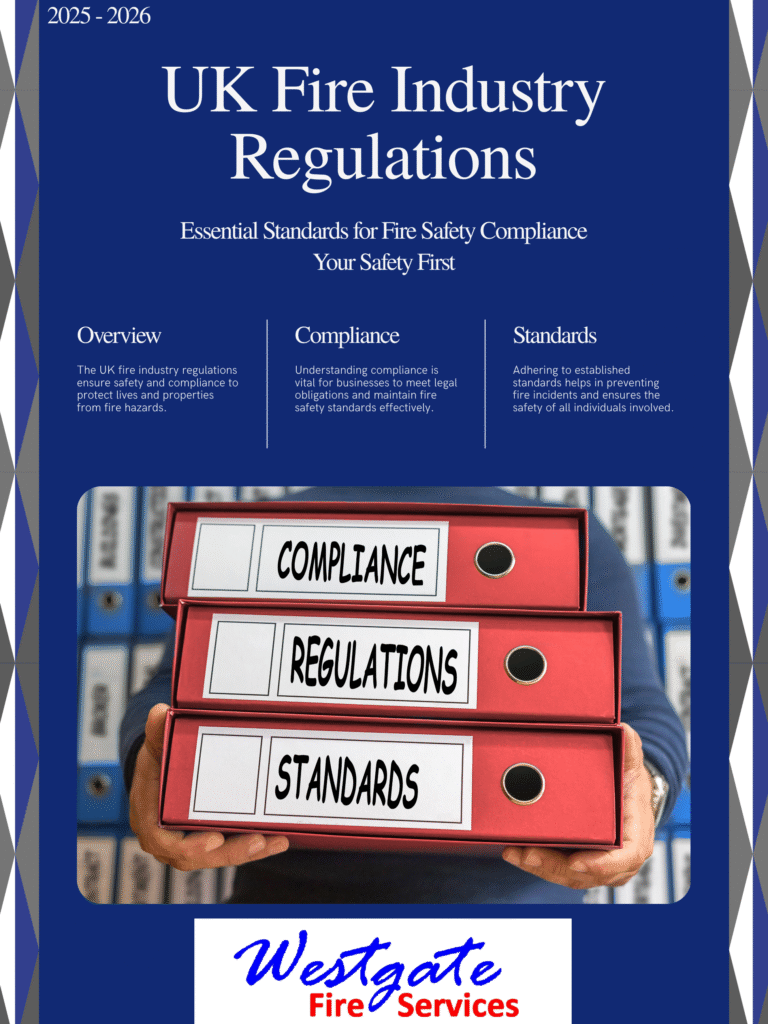Safety Season Episode 2: Identifying & Preventing Electrical Hazards ⚡🔥
Safety Season Episode 02: Identifying & Preventing Electrical Hazards ⚡🔥 Westgate Fire Services Safety Season: Episode 02 Safety Season Episode...
Understanding UK fire industry regulations and standards is essential for ensuring legal compliance, protecting lives, and maintaining safe commercial and industrial premises.
This is why Westgate Fire Services is committed to making this information clear, accessible, and transparent—not only for clients, but for the wider public. By offering a downloadable PDF and maintaining this online resource, Westgate ensures that businesses have easy access to the regulations that form the foundation of all fire risk assessments and services they deliver. These standards are not just guidelines—they are the basis for everything Westgate Fire Services does as a trusted provider in the UK fire safety industry.

Fire safety in the UK is governed by a robust set of laws, codes, and guidance documents—each playing a critical role in ensuring protection for people, property, and businesses. The following regulations and standards form the foundation of all work carried out by Westgate Fire Services, influencing everything from risk assessments to emergency system design.
The cornerstone of UK fire safety law, the Regulatory Reform (Fire Safety) Order 2005 places a legal duty on employers and building owners to assess fire risks and implement appropriate safety measures.
Introduced to strengthen fire safety in multi-occupied residential buildings, the Fire Safety (England) Regulations 2022 set out specific duties for building owners and managers, including new requirements for high-rise properties.
The Fire Safety Act 2021 clarifies that fire risk assessments must include the structure, external walls, and flat entrance doors in multi-occupied residential buildings, closing previous legal grey areas.
PAS 9980:2022 provides a structured approach for assessing the fire risk of external wall systems in existing multi-occupied residential buildings, helping responsible persons make informed, proportionate decisions about remediation.
BS 5306 sets the standards for the selection, installation, inspection, and maintenance of portable fire extinguishers, ensuring they are fit for purpose and ready when needed most.
BS 5839 provides comprehensive guidance on the design, installation, commissioning, and maintenance of fire detection and alarm systems, ensuring effective early warning in commercial and public buildings.
BS 5266 outlines the requirements for the design, installation, and maintenance of emergency lighting systems, ensuring safe evacuation routes during power failures or emergencies.
BS 7671, also known as the IET Wiring Regulations, sets the national standard for electrical installation safety, covering everything from design to inspection to ensure systems are compliant and risk-free.
BS 5499 defines the design and use of safety signs, including fire exit and escape route signage, to ensure clear, consistent visual guidance during an emergency evacuation.
BS 476 sets the standards for fire resistance testing of building materials and structures, helping to evaluate their ability to withstand fire and protect occupants.
BS 9999 offers comprehensive guidance on fire safety best practices throughout the design, management, and occupation of buildings to enhance protection and ensure compliance.
BS 9991 provides detailed guidance on fire safety measures specifically for the design, management, and use of residential buildings, ensuring the protection of occupants in domestic environments.
BS 476 sets the standards for fire resistance testing of building materials and structures, helping to evaluate their ability to withstand fire and protect occupants.
BS 9999 offers comprehensive guidance on fire safety best practices throughout the design, management, and occupation of buildings to enhance protection and ensure compliance.
BS 9991 provides detailed guidance on fire safety measures specifically for the design, management, and use of residential buildings, ensuring the protection of occupants in domestic environments.
BS 9251 sets out the code of practice for the design, installation, and maintenance of fire sprinkler systems in domestic and residential buildings to enhance early fire suppression and occupant safety.
BS 7273 provides guidance on the correct operation and testing of fire detection and alarm systems, including emergency door release mechanisms, to ensure reliable fire protection performance.
BS 8674 specifies requirements and test methods for fire safety performance of external wall systems in multi-storey buildings, helping to prevent fire spread on building exteriors.
Fire safety in the UK is governed by a robust set of laws, codes, and guidance documents—each playing a critical role in ensuring protection for people, property, and businesses. The following regulations and standards form the foundation of all work carried out by Westgate Fire Services, influencing everything from risk assessments to emergency system design.

Fire Safety Risk Assessment: Offices and Shops
This official government guide provides step-by-step advice on how to carry out a fire risk assessment in offices, shops, and similar non-domestic premises. It outlines how to identify fire hazards, evaluate risks to staff and customers, and implement appropriate fire safety measures to comply with the Regulatory Reform (Fire Safety) Order 2005. The document includes practical examples and legal responsibilities for employers and building managers in commercial environments.

Fire Safety Risk Assessment: Factories and Warehouses
This government-issued guide helps employers, managers and occupiers of factories and warehouses conduct systematic fire risk assessments in line with the Regulatory Reform (Fire Safety) Order 2005. It covers hazard identification, fire prevention, emergency planning, and ongoing management of fire precautions—especially important where hazardous substances, machinery, or large volumes of combustible storage are involved

Fire Safety Risk Assessment: Sleeping Accommodation
This official guidance is designed to help owners and managers of premises with sleeping areas—such as hostels, hotels, bed‑and‑breakfasts, HMOs, and staff ‘sleep‑in’ zones—carry out compliant fire risk assessments under the Regulatory Reform (Fire Safety) Order 2005. It provides a five‑step process to identify hazards, evaluate risks to occupants, and implement fire precautions tailored to sleeping environments, with examples, checklists, and advice on record‑keeping, reviewing, and emergency planning

Fire Safety Risk Assessment: Educational Premises
This government guide helps headteachers, governors, facilities managers, and building owners carry out compliant fire risk assessments specifically in educational settings—from nursery and primary schools to universities and adult education centres. It explains the five-step assessment process under the Regulatory Reform (Fire Safety) Order 2005, covering key considerations such as identifying fire hazards, planning safe evacuation routes, training for staff and pupils, and keeping effective records to ensure legal compliance and occupant safety.

Fire Safety Risk Assessment: Small & Medium Places of Assembly
This official guide is designed for managers and owners of small (up to 60 people) and medium (up to 300 people) assembly venues—such as pubs, village halls, churches, and community centres—to carry out effective fire risk assessments under the Regulatory Reform (Fire Safety) Order 2005 en.wikipedia.org+14gov.uk+14gov.uk+14. It outlines a structured five-step process to identify hazards, assess risks, and implement practical fire safety measures suitable for less-complex premises, including advice on flammable materials, occupancy management, emergency planning, and maintenance of fire precautions.

Fire Safety Risk Assessment: Large Places of Assembly
This official government guide supports owners, managers, and responsible persons of large assembly venues—such as sports stadiums, exhibition centres, large nightclubs, shopping mall commons, and churches—on carrying out comprehensive fire risk assessments under the Regulatory Reform (Fire Safety) Order 2005. It details a structured approach across five key steps, covering hazard identification, emergency planning, crowd management, and ongoing review, with particular focus on high-capacity settings and licencing requirements.

Fire Safety Risk Assessment: Theatres, Cinemas & Similar Premises
This official government guide targets operators, managers, and owners of theatres, cinemas, concert halls, and similar entertainment venues. It explains how to conduct a compliant fire risk assessment under the Regulatory Reform (Fire Safety) Order 2005, offering practical recommendations on hazard identification, audience management, means of escape, fire detection systems, and emergency planning. Designed to help responsible persons ensure effective fire precautions and ongoing management tailored to crowded, performance-based environments.

Fire Safety Risk Assessment: Open-Air Events and Venues
This official government guide is designed for organisers and responsible persons overseeing outdoor events and venues—including zoos, music festivals, sporting events, firework displays, and markets. It provides a structured approach to conducting fire risk assessments under the Regulatory Reform (Fire Safety) Order 2005, covering hazard identification, emergency planning, crowd management, and fire safety measures specific to open-air settings. The guide helps ensure compliance with fire safety law and promotes the safety of attendees and staff at such events.

Fire Safety Risk Assessment: Healthcare Premises
This official government guide assists employers, managers, and responsible persons in healthcare settings—such as hospitals and medical centres—in conducting comprehensive fire risk assessments under the Regulatory Reform (Fire Safety) Order 2005. It provides a structured approach to identifying fire hazards, evaluating risks to patients and staff, and implementing necessary fire precautions and management arrangements to ensure safety and compliance. The guide is tailored to the unique needs of healthcare environments, addressing factors like mobility-impaired individuals, medical equipment, and high-occupancy areas.

Fire Safety Risk Assessment: Transport Premises and Facilities
This official government guide provides comprehensive instructions for managers, employers, and occupiers of transport premises—including train stations, bus terminals, airports, tunnels, and ferry ports—to conduct fire risk assessments in compliance with the Regulatory Reform (Fire Safety) Order 2005. It outlines a structured five-step process to identify fire hazards, evaluate risks to staff and passengers, and implement appropriate fire precautions and management arrangements tailored to the unique needs of transport facilities.
Safety Season Episode 02: Identifying & Preventing Electrical Hazards ⚡🔥 Westgate Fire Services Safety Season: Episode 02 Safety Season Episode...
What Is Arson & Vandalism? 🚨 Arson is the criminal act of deliberately setting fire to property, while vandalism refers...
Ensure workplace safety with PAT testing and emergency lighting maintenance from Westgate Fire Services. We help businesses in Lincolnshire and...